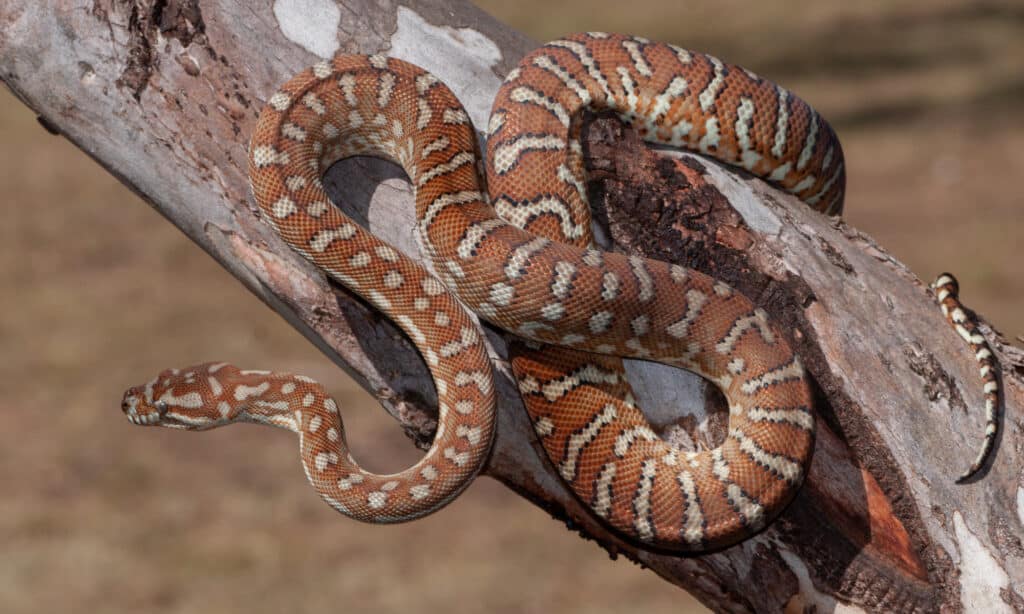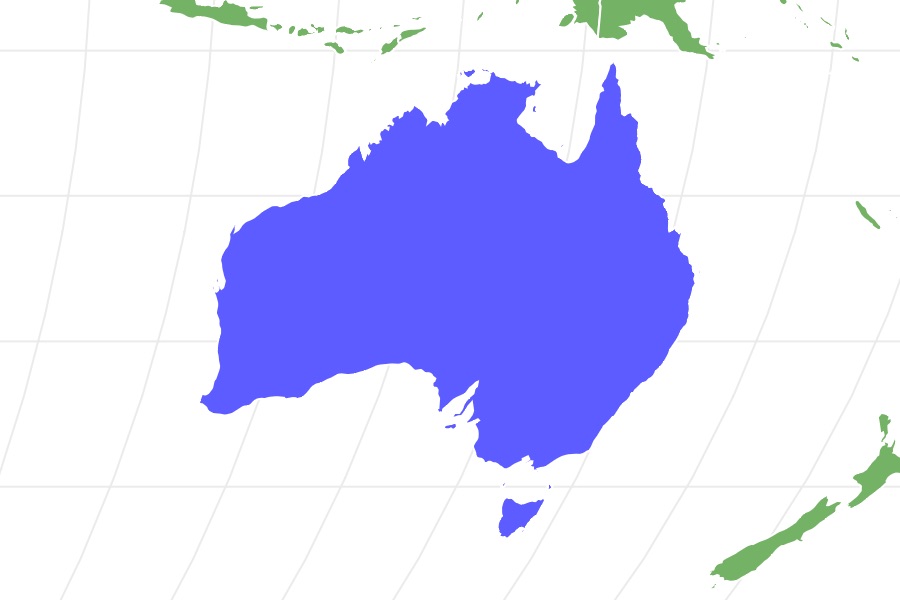Bredl’s Python
.jumbotron {
background-image: url(“https://a-z-animals.com/media/2022/06/morelia-bredli-shutterstock_2027192090-400×300.jpg”);
}
}
@media only screen and (min-width: 641px) and (max-width: 920px) {
.jumbotron {
background-image: url(“https://a-z-animals.com/media/2022/06/morelia-bredli-shutterstock_2027192090-470×370.jpg”);
}
}
@media only screen and (min-width: 921px) {
.jumbotron {
background-image: url(“https://a-z-animals.com/media/2022/06/morelia-bredli-shutterstock_2027192090.jpg”);
}
}
Bredl’s Python
Morelia Bredli
These snakes love to climb trees, and young snakes often hide high in the branches.
Bredl’s Python Scientific Classification
- Kingdom
- Animalia
- Phylum
- Chordata
- Class
- Reptilia
- Order
- Squamata
- Family
- Pythonidae
- Genus
- Morelia
- Scientific Name
- Morelia Bredli
Read our Complete Guide to Classification of Animals.
Bredl’s Python Conservation Status
Bredl’s Python Facts
- Prey
- Marsupials, birds, feral cats, rabbits
- Name Of Young
- Hatchling, neonate
- Group Behavior
-
- Solitary except during mating season
- Fun Fact
- These snakes love to climb trees, and young snakes often hide high in the branches.
- Other Name(s)
- Bredl’s python, Centralian python, Centralian carpet python, central Australian carpet python, Bredl’s carpet python
This post may contain affiliate links to our partners like Chewy, Amazon, and others. Purchasing through these helps us further the A-Z Animals mission to educate about the world’s species..

Discover alligator-eating snakes, spiders larger than your phone, and 1000 more incredible animals in our daily FREE email.
.photo-gallery {
–margin: 0px auto 0px;
–padding: 0px 0px 0px 0px;
}
.gallery-link {
background-image: url(“https://a-z-animals.com/media/2022/06/morelia-bredli-shutterstock_2152784477-1024×614.jpg”);
background-repeat: no-repeat;
background-size: cover;
background-position: center;
height: 500px;
justify-content: center;
text-align: center;
align-items: center;
display: flex;
border: 2px solid #000;
}
.gallery-link img {
height: 50%;
}
@media only screen and (max-width: 768px) {
.gallery-link {
height: 300px !important;
}
}
View all of the Bredl’s Python images!
Bredl’s python is a nonvenomous snake that lives in an isolated mountain range in central Australia.
This semi-arboreal snake shelters in tree hollows and crevices and comes out to hunt when temperatures in its harsh climate are more comfortable. It is a docile snake that hunts various warm-blooded prey including marsupials, birds, and feral cats in its home range.
3 Amazing Facts About Bredl’s Python
- Wild female Bredl’s pythons only breed every 3-4 years because of the strain it takes on the body.
- It only lives in central Australia near Alice Springs in the MacDonnell range.
- People originally assumed that it was a desert variant of carpet python.
Where to find Bredl’s Python
Bredl’s python inhabits a mountainous area in central Australia, calling the southern region of the Northern Territory home. It is comfortable in various habits including savanna, forests, inland wetlands, cliffs and mountain peaks, and desert. This snake is also known as the Centralian carpet python. Most individuals are found within 300 miles of the town of Alice Springs in the MacDonnell Mountain range.
button.pulse {
transform: scale(1); animation: pulse 2s infinite;
box-shadow: 0 0 0 0 rgba(11, 247, 25, 1);
}
@keyframes pulse {
0% { transform: scale(0.90); box-shadow: 0 0 0 0 rgba(11, 247, 25, 0.5); }
60% { transform: scale(1); box-shadow: 0 0 0 15px rgba(11, 247, 25, 0); }
100% { transform: scale(0.90); box-shadow: 0 0 0 0 rgba(11, 247, 25, 0); }
}
This harsh habitat regularly sees summer daytime highs over 100F and winter lows below freezing. Rain in the area is highly seasonal, and the summer tends to see more precipitation than winter. The area surrounding the mountain range is a brutally hot desert that pythons cannot pass, and which makes the mountains an oasis for many animal species.
This snake is semi-arboreal and frequents trees and shrubs, especially near riverbanks; it also occurs in Acacia woodland. It shelters in caves and rock crevices during the day through the hot summer months and becomes active at night when temperatures fall. However, spring and fall bring cooler night-time temperatures, and the snake ventures out during the day. There can be as much as a 30-degree difference between day and night temperatures all year long.
This species feeds on possums, rock wallabies, and birds nesting in tree hollows. It’s an opportunistic predator, so it also preys on feral cats and rabbits when they’re available.
Reproduction
Data on mating in the wild is limited, most of what we know about breeding them comes from breeders in different parts of the world. In captivity, most male Bredl’s pythons show interest in breeding in their third year, and females are often four or five years old before they begin to breed.
In the wild, scientists believe that mating occurs during August and September. Then, from October through December, females lay 13-47 eggs that hatch during January and February.
Bredl’s Python Scientific Name and Classification
Naming in the scientific community sometimes reflects the location where they find an organism, sometimes its color, and sometimes to honor a person. Josef Bredl (1948-2007) was an Australian herpetologist. He started the Edward River Crocodile Farm and owned the Renmark Reptile Park in South Australia.
This python, while it is currently considered a full species, may find itself moved into the realm of subspecies. Some scientists include it with the carpet python (Morelia spilota) complex and when scientists do more genetic research, they may discover that Bredl’s python fits better there. That said, its natural habitat is quite isolated from the other Morelia species.
It was first discovered in the 1870s, but at the time was considered a desert variation of the very common carpet python, and they called it the Centralian carpet python. Graham Gow described it as a new species in 1981 – calling it Bredl’s python (Morelia bredli). He cited its much smaller head and dorsal scales and isolation from any other python species as justification for elevating it to the status of full species.
Bredl’s Python Population and Conservation Status
As of 2017, the IUCN Redlist of Threatened Species considered Bredl’s python a species of “Least Concern.” Within its home range, it is common with a stable population. At one time, there was a high demand for this species in the illegal pet trade, but there are enough captive-bred individuals now that finding one from a breeder shouldn’t be a problem.
Breeders in some locations have cross-bred Bredl’s python with carpet pythons to come up with new color patterns. However, this practice is falling out of favor in some areas in order to preserve the species in its original state.
Identifying Bredl’s Python: Appearance and Description
This species averages between 6.5 and 8.5 feet long with the occasional 9-10 footer. Despite its sometimes large size, it is easy to handle.
Unlike those in the carpet python complex, Bredl’s python doesn’t show as much pattern variation. It is usually reddish-brown with white to beige spots or bands which are usually outlined in black. It has a powerful constrictor-type body and its scales are smooth and glossy.
This snake has that classic “python” head, with the large jaw muscles typical of Morelia species snakes. It is somewhat triangular with a blunt snout and elliptical pupils. Bredl’s python has large, noticeable heat-sensing pits both on the upper front of its snout and along the lower rear labials.

Rosa Jay/Shutterstock.com
Pictures and Videos of Bredl’s Python

Ken Griffiths/Shutterstock.com

Ken Griffiths/Shutterstock.com
How Dangerous is Bredl’s Python
These snakes are nonvenomous, so a bite shouldn’t cause permanent damage. However, their teeth are something to avoid. Owing to their Morelia ancestry, they have big teeth and powerful jaw muscles. Many species in this genus prey on birds and other fast-moving animals, so they have specialized jaws to make capturing them a possibility.
Scary teeth aside, breeders and keepers say this is a remarkably calm snake. It only rarely strikes, and most often, those strikes are food-response and not aggression.
Bredl’s Python Behavior and Humans
This species, like other Australian natives, is protected against export to other countries. The snakes live in a fairly remote part of the country that doesn’t see a lot of traffic. As a result, there isn’t a vast amount of research on them.
This species is becoming popular in the pet trade, and for a while was one of the most sought after in the European Union. Most specimens sold as pets are captive-bred individuals that came from Germany or the Czech Republic breeding lines.
Next Up
Most boa species live across the ocean in the New World, but there are a few exceptions.
- Dumeril’s Boa (Acrantophis dumerili)
- Madagascar tree boa (Sanzinia madagascariensis)
- Kenyan Sand Boa (Eryx colubrinis)
View all 192 animals that start with B
Bredl’s Python FAQs (Frequently Asked Questions)
Are Bredl’s pythons dangerous?
No, there are actually very docile snakes that only rarely bite. When they do, it can hurt like crazy because they have big teeth and strong jaws. However, they’re not venomous.
How do Bredl’s pythons hunt?
These snakes usually ambush their prey, but they’re also known to actively forage.
Are Bredl’s pythons aggressive?
No. These snakes are mild-mannered and easy to handle.
Where do Bredl’s pythons live?
Only in central Australia, leading to one of their common names, the Centralian carpet python.
What do Bredl’s pythons eat?
They’re opportunistic, and will eat whatever they can – but they prefer warm-blooded animals like marsupials and birds.
Sources
- Centralian Carpet Python | IUCN Redlist of Threatened Species, Available here: https://www.iucnredlist.org/species/42494066/42494080
- Bredl’s Python | Niabi Zoo, Available here: https://www.niabizoo.com/animals-habitats-details/bredls-python/
- Bredl’s Python Care Sheet | The Tye Died Iguana.com, Available here: https://thetyedyediguana.com/content/care-sheets/Bredl’s-Python-Morelia-bredli-care-sheet.pdf
















